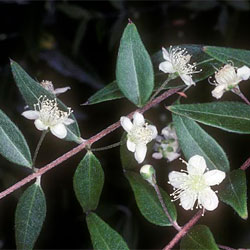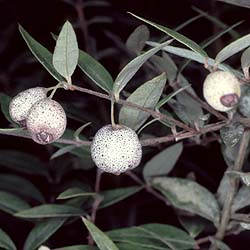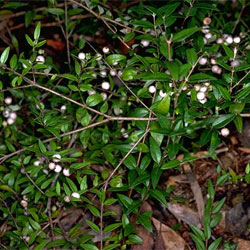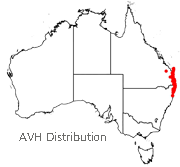Austromyrtus dulcis
 |
 |
 |
Midgen, Midgen Berry
Austromyrtus dulcis (C.T.White) L.S.Sm.
There are at least eleven species of Austromyrtus endemic to Australia, the majority occurring on the east coast from central New South Wales to northern Queensland. They are small trees or shrubs and can be found in woodlands, heath, forests or rainforest fringes.
 Austromyrtus
dulcis, known as Midgen Berry, occurs commonly from around Valla, New South
Wales, to Fraser Island, Queensland, as a spreading shrub up to 2 m tall.
Its most frequent occurrence is in sandy soils in heath, scrub or open forests
and occasionally on the margins of rainforests.
Austromyrtus
dulcis, known as Midgen Berry, occurs commonly from around Valla, New South
Wales, to Fraser Island, Queensland, as a spreading shrub up to 2 m tall.
Its most frequent occurrence is in sandy soils in heath, scrub or open forests
and occasionally on the margins of rainforests.
The leaves of A. dulcis are glossy dark green lanceolate 9-30 mm long by 3-10 mm wide with numerous conspicuous oil glands. They are arranged in opposite rows. The undersurface of the leaves has a dense covering of appressed hairs giving it a pale appearance. The young coppery coloured growing shoots are densely silky hairy.
The flowers are 7-1 0 mm in diameter and have white ovate petals. They are usually borne in clusters of 2-5 flowers in the upper axils, although solitary flowers are also common. In its natural habitat A. dulcis flowers in spring and summer while in Canberra the flowering time is summer to mid-autumn.
An attractive period for the plant is the fruiting stage. The fruits are berries containing 3-9 pale brown seeds. They are white and covered in small blue black spots, giving the fruit a mauvish appearance. The fruit are edible and have a sweet taste.
Austromyrtus dulcis is a relatively easy species to propagate. Fresh cleaned seed germinates in 3-4 weeks while uncleaned fruits take about a week longer. Although the testa (the outer coat) of the seed is hard no mechanical scarification is necessary. Propagation from cuttings is also easy.
The species has been performing well in cultivation at the Australian National Botanic Gardens as a low shrub on the margins of the rainforest gully. In full sun it forms a dense spreading shrub up to 40 cm high by 1.4 m in diameter, while in more shaded areas it becomes a more open ground cover. It forms an excellent shrub in sandy coastal situations where not directly exposed to salt winds.
Other requirements for cultivation are an assured moisture level and some overhead tree shelter in areas of severe frosts. Little maintenance is required and pruning is only necessary to achieve a particular shape such as. a low hedge. The plant appears relatively free from pests and diseases.
Text by: Ron Jackson, 1982
Name meaning: Austromyrtus dulcisAustromyrtus - from the Latin, australis, southern and myrtus, from the Greek name for myrtle; dulcis - Latin for sweet |
![An Australian Government Initiative [logo]](/images/austgovt_brown_90px.gif)

